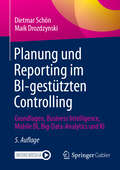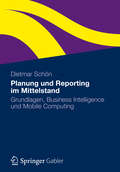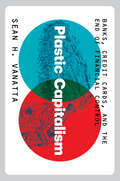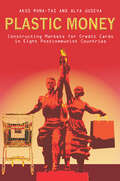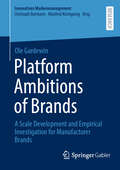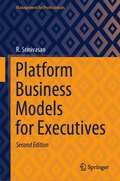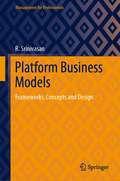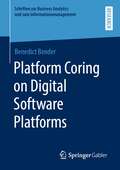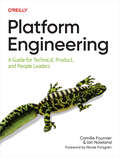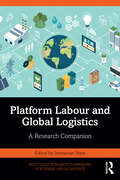- Table View
- List View
Planung und Reporting im BI-gestützten Controlling: Grundlagen, Business Intelligence, Mobile BI, Big-Data-Analytics und KI
by Dietmar Schön Maik DrozdzynskiPlanungs- und Reportinglösungen leiden in vielen Unternehmen immer noch unter mangelnder Datenqualität, sind unzureichend integriert und häufig zeit- und kostenintensiv. Dieses praxisorientierte Buch zeigt Schritt für Schritt, wie es anders geht. Es wird systematisch gezeigt, wie moderne Planungs- und Reportingsysteme im BI-gestützten Controlling mit dem Einsatz von Data-Warehouse- und Big-Data-Technologie aufgebaut und sinnvoll um KI-gestützte Features ergänzt werden können.
Planung und Reporting im Mittelstand
by Dietmar SchönIn mittelständischen Unternehmen klafft eine große Lücke zwischen Planung und Kontrolle. Planungs- und Reportinglösungen im Controlling sind meist in einfachen Tabellenkalkulationsprogrammen und Reportgeneratoren innerhalb der vorhandenen Anwendungsprogramme abgebildet. Dies ist zeit- und kostenaufwendig und liefert nicht die erforderliche Transparenz für das Management. Wichtige Informationen aus anderen Bereichen werden nicht oder nur unzureichend mit einbezogen. Dieses lösungsorientierte Buch zeigt, dass es auch anders geht: Schritt für Schritt wird dargestellt, wie sich Business Intelligence mit dem Einsatz von Data Warehouse-Technologie zur Umsetzung leistungsstarker Planungs- und Reportingsysteme anbietet und im Unternehmen eingeführt wird.
Planung und Umsetzung sicherer Events: Handeln und Lernen aus Erfahrungen bei Veranstaltungen (essentials)
by Stefan Luppold Marcus MoroffMarcus Moroff und Stefan Luppold beschreiben in diesem essential die wesentlichen Elemente, die im Ablauf eines Events - Planung, Realisierung und Nachbetrachtung - aus der Perspektive bewusster Sicherheit unverzichtbar sind. Die Autoren stellen einen ganzheitlichen Ansatz vor, bei dem Sicherheit als selbstverst#65533;ndliches Ergebnis entsteht. Sicherheit bei Events erfordert eine konsequente Herangehensweise, die den Leserinnen und Lesern in kompakter Form zug#65533;nglich gemacht wird.
Planung von innerbetrieblichen Transportsystemen: Fahrzeugsysteme (Intralogistik)
by Thorsten Schmidt Johannes Fottner Stefan Galka Sebastian Habenicht Eva Klenk Ingolf MeinhardtDieses Buch beschreibt bewährte, praxistaugliche Methoden zur Planung innerbetrieblicher Transportsysteme. Der Fokus liegt auf den wesentlichen Systemen und Förderfahrzeugen, die derzeit in der Industrie eingesetzt werden: Gabelstapler, fahrerlose Transportfahrzeuge, Routenzüge und Elektrohängebahnen. Neben einer Beschreibung relevanter Systemelemente und Gestaltungsmöglichkeiten liefert das Buch Empfehlungen zur Auswahl eines geeigneten Systems entsprechend der individuellen Anforderungen. Planungsschritte von der Erhebung von Plandaten bis zur Umsetzung werden vorgestellt. Methoden, die bei Planungsentscheidungen wie der Bestimmung der Anzahl benötigter Fahrzeuge helfen, sind detailliert beschrieben; ihre Anwendung wird anhand von Fallbeispielen demonstriert. Do's and Dont’s, basierend auf Erfahrungen von Praktikern und Wissenschaftlern, tragen dazu bei, Planungsfehler zu vermeiden.Das Buch wendet sich an Planer und Betreiber derartiger Systeme, Studierende einschlägiger Studienfächer bekommen einen vertieften Einblick in die Umsetzung der Methoden.
Plastic Capitalism: Banks, Credit Cards, and the End of Financial Control
by Sean H. VanattaHow bankers created the modern consumer credit economy and destroyed financial stability in the process American households are awash in expensive credit card debt. But where did all this debt come from? In this history of the rise of postwar American finance, Sean H. Vanatta shows how bankers created our credit card economy and, with it, the indebted nation we know today. America&’s consumer debt machine was not inevitable. In the years after World War II, state and federal regulations ensured that many Americans enjoyed safe banks and inexpensive credit. Bankers, though, grew restless amid restrictive rules that made profits scarce. They experimented with new services and new technologies. They settled on credit cards, and in the 1960s mailed out reams of high-interest plastic to build a debt industry from scratch. In the 1960s and &’70s consumers fought back, using federal and state policy to make credit cards safer and more affordable. But bankers found ways to work around local rules. Beginning in 1980, Citibank and its peers relocated their card plans to South Dakota and Delaware, states with the weakest consumer regulations, creating &“on-shore&” financial havens and drawing consumers into an exploitative credit economy over which they had little control. We live in the world these bankers made.
Plastic Donuts: Giving That Delights the Heart of the Father
by Jeff AndersonOnce you see your gifts from God's perspective, your giving will never be the same. When she was a toddler, Jeff Anderson's daughter opened his eyes to how delighted God is with our gifts. She brought him a plastic donut from her play kitchen, and he was surprised by the intensity of his reaction. His delight in receiving this simple gift--and his daughter's joy in giving it--led him to dig deeper. Anderson would not rest until he found the scriptural connection between our gifts and God's heart. Plastic Donuts removes the awkwardness and uncertainty that often accompany discussions about giving. Now you can think differently-and biblically-about what and how you give. Your gifts can capture God's attention and connect you more intimately with His heart. Plastic Donuts brings everyone--leaders and followers, teachers and learners--onto the same page. From the Hardcover edition.
Plastic Free: The Inspiring Story of a Global Environmental Movement and Why It Matters
by Joanna Atherfold Finn Rebecca Prince-RuizIn July 2011, Rebecca Prince-Ruiz challenged herself to go plastic free for the whole month. Starting with a small group of people in the city of Perth, the Plastic Free July movement has grown into a 250-million strong community across 177 countries, empowering people to reduce single-use plastic consumption and create a cleaner future.This book explores how one of the world’s leading environmental campaigns took off and shares lessons from its success. From narrating marine-debris research expeditions to tracking what actually happens to our waste to sharing insights from behavioral research, it speaks to the massive scale of the plastic waste problem and how we can tackle it together. Interweaving interviews from participants, activists, and experts, Plastic Free tells the inspiring story of how ordinary people have created change in their homes, communities, workplaces, schools, businesses, and beyond.It is easy to feel overwhelmed in the face of global environmental problems and wonder what difference our own actions could possibly make. Plastic Free offers hope for the future through the stories of those who have taken on what looked like an insurmountable challenge and succeeded in innovative and practical ways, one step—and one piece of plastic—at a time.
Plastic Money: Constructing Markets for Credit Cards in Eight Postcommunist Countries
by Akos Rona-Tas Alya GusevaIn the United States, we now take our ability to pay with plastic for granted. In other parts of the world, however, the establishment of a "credit-card economy" has not been easy. In countries without a history of economic stability, how can banks decide who should be given a credit card? How do markets convince people to use cards, make their transactions visible to authorities, assume the potential risk of fraud, and pay to use their own money? Why should merchants agree to pay extra if customers use cards instead of cash? In Plastic Money, Akos Rona-Tas and Alya Guseva tell the story of how banks overcame these and other quandaries as they constructed markets for credit cards in eight postcommunist countries. We know how markets work once they are built, but this book develops a unique framework for understanding how markets are engineered from the ground up#151;by selecting key players, ensuring cooperation, and providing conditions for the valuation of a product. Drawing on extensive interviews and fieldwork, the authors chronicle how banks overcame these hurdles and generated a desire for their new product in the midst of a transition from communism to capitalism.
Plastic Water
by Kane Race Emily Potter Gay HawkinsHow did branded bottles of water insinuate themselves into our daily lives? Why did water become an economic good -- no longer a common resource but a commercial product, in industry parlance a "fast moving consumer good," or FMCG? Plastic Water examines the processes behind this transformation. It goes beyond the usual political and environmental critiques of bottled water to investigate its multiplicity, examining a bottle of water's simultaneous existence as, among other things, a product, personal health resource, object of boycotts, and part of accumulating waste matter. Throughout, the book focuses on the ontological dimensions of drinking bottled water -- the ways in which this habit enacts new relations and meanings that may interfere with other drinking water practices.The book considers the assemblage and emergence of a mass market for water, from the invention of the polyethylene terephthalate (PET) bottle in 1973 to the development of "hydration science" that accompanied the rise of jogging in the United States. It looks at what bottles do in the world, tracing drinking and disposal practices in three Asian cities with unreliable access to safe water: Bangkok, Chennai, and Hanoi. And it considers the possibility of ethical drinking, examining campaigns to "say no" to the bottle and promote the consumption of tap water in Canada, the United States, and Australia.
Plastic Water: The Social and Material Life of Bottled Water (The\mit Press Ser.)
by Kane Race Emily Potter Gay HawkinsHow and why branded bottles of water have insinuated themselves into our daily lives, and what the implications are for safe urban water supplies.How did branded bottles of water insinuate themselves into our daily lives? Why did water become an economic good—no longer a common resource but a commercial product, in industry parlance a “fast moving consumer good,” or FMCG? Plastic Water examines the processes behind this transformation. It goes beyond the usual political and environmental critiques of bottled water to investigate its multiplicity, examining a bottle of water's simultaneous existence as, among other things, a product, personal health resource, object of boycotts, and part of accumulating waste matter. Throughout, the book focuses on the ontological dimensions of drinking bottled water—the ways in which this habit enacts new relations and meanings that may interfere with other drinking water practices.The book considers the assemblage and emergence of a mass market for water, from the invention of the polyethylene terephthalate (PET) bottle in 1973 to the development of “hydration science” that accompanied the rise of jogging in the United States. It looks at what bottles do in the world, tracing drinking and disposal practices in three Asian cities with unreliable access to safe water: Bangkok, Chennai, and Hanoi. And it considers the possibility of ethical drinking, examining campaigns to “say no” to the bottle and promote the consumption of tap water in Canada, the United States, and Australia.
Plastics: America's Packaging Dilemma
by Ellen Feldman Nancy WolfPlastics explains what plastics are, how they are made, how they are used, and the problems and opportunities they bring.
Plastiq
by Jeffrey J. Bussgang Gaurav Jain Liroy Haddad Luke Langford Matt Noble"As Eliot Buchanan and his co-founder, Daniel Choi, entered the elevator to leave the Flybridge Capital office in Boston’s Back Bay, Buchanan could not help but smile. When the doors closed, he felt like cheering out loud. They had just signed a term sheet to raise a $2 million seed round of funding for their company, Plastiq, with Flybridge and another Boston-based firm, Atlas Ventures. The two VCs had been impressed with the team’s plan to enable consumers to use credit cards for large-ticket purchases, like college tuition and automobiles, something rarely possible today. But as the elevator descended toward the ground floor, Buchanan’s smile began to disappear. The VCs had committed to invest several million dollars in his plan, but the next time he met with them, they would be focused on execution and customer adoption. He had a lot of work to do. In particular, he had to figure out his entire go-to-market strategy—how to sell the innovative offering he had envisioned and hire the team to do so."
Plataforma: Hazte oír en un mundo ruidoso
by Michael HyattMichael Hyatt, uno de los blogueros más importantes del mundo en el área de negocios, nos ofrece una guía práctica para crear y desarrollar una poderosa plataforma.Para tener éxito en el mercado actual, usted debe tener dos bienes estratégicos: un producto atractivo y una importante plataforma. En esta guía paso a paso, Michael Hyatt, ex gerente general y actual presidente de la editorial Thomas Nelson, lleva a los lectores, entre bastidores, al nuevo mundo del éxito en las redes sociales. Hyatt muestra lo que están haciendo ahora los autores de mayor ventas, oradores, emprendedores, músicos y otras personas creativas para conseguir clientes en el abarrotado mercado actual. Hyatt habla desde su propia experiencia, pues es el escritor de uno de los 800 blogs más importantes del mundo y tiene más de 100.000 seguidores en Twitter. Su amplia y creciente plataforma es la base de su exitosa práctica como escritor, orador y consultor.En Plataforma, Hyatt enseñará a los lectores no solo a ampliar su influencia, sino también a convertirla en dinero y construir una carrera profesional sostenible. ¿La clave? Establecer una plataforma. Nunca ha sido más fácil, económico y viable que ahora... El libro incluye:estrategias comprobadasfórmulas que se pueden reaplicar fácilmenteconsejos útiles
Platform Ambitions of Brands: A Scale Development and Empirical Investigation for Manufacturer Brands (Innovatives Markenmanagement)
by Ole GardewinThe platform economy is gaining increasing importance. Digital platforms can be found in more and more areas of consumers' daily lives. One area particularly affected by this is online shopping, which is becoming increasingly popular. Large online retailers have achieved monopolistic positions, and the majority of online shopping takes place on their marketplaces. This presents significant challenges for manufacturer brands. Recently, some of them have started operating their own platforms to counteract the risks within the platform economy, the so-called Brand Flagship Platforms. This book not only presents the development of the first empirical measurement scale for assessing the benefit dimensions of these Brand Flagship Platforms but also takes it a step further by analyzing the behavioral impact of these platforms on consumers’ attachment to the respective brands and, ultimately, on their purchasing behavior. This serves both researchers and practitioners in assessing the impact of digital platforms on their own brand.
Platform Business Models for Executives (Management for Professionals)
by R. SrinivasanThis book takes a practice approach to studying platform business models. Drawing from the growing academic literature as well as the practice world, this book intends to provide a framework for analysing platform business firms. Leveraging on the early literature on network economics (that was largely analytical) and the popular writing about new organizations, this book takes a strategic perspective. It answers the five big strategy questions about platform business firms: a. What are platform business models, and how are they different from others; b. How do platform business firms operate, and what value do they create? To whom and how; c. What are those resources that platforms possess and leverage to create and sustain their competitive advantage over others; d. Why and how are they successful? Why do they perform differently from others? What metrics of performance should we use to study and analyse their performance; e. Is this business model sustainable? What determines the longevity of such firms? What are the regulatory and social challenges that these platform business firms face? How do regulators and the larger society manage the disproportionate power distribution among such firms?The book is strategic in nature and highlights the resources defining the strategies of successful platform business firms. In doing so, it provides a field guide for entrepreneurs and managers embarking on building a platform, by providing a portfolio of decisions to make. Though the frameworks could be generalized, the book focuses on platform businesses, rather than societal platforms. With a few extensions, it is possible that these frameworks could be easily applied to non-profit and or social enterprises as well.
Platform Business Models: Frameworks, Concepts and Design (Management for Professionals)
by R. SrinivasanThis book introduces platform firms as unique business models. Leveraging on the early literature on network economics and strategy frameworks, this book explores how platform business firms evolve in the modern business world. Taking a strategic perspective, this book engages the reader with core concepts, case studies, and frameworks for analyzing platform business firms. This book differentiates platform business firms from traditional pipeline firms; explores engagement with different actors, value creation, and operations of platforms; elucidates resources and capabilities of platform firms that provide them sustained competitive advantage; analyzes performance levers in operating platform business models, including complementarities with other business models; and discusses the sustainability of platform business models, in the face of regulatory and societal challenges, among others. The book is designed as a primer for entrepreneurs setting up and operating platform business firms, senior managers in large corporations repurposing their resources to initiate network dynamics in their businesses, early career managers, and professionals engaging with myriad platform firms for their professional and personal needs. This book intends to provide a decision-maker with a portfolio of decisions to make to create, operate, sustain, and generate value out of a platform business firm. It is also useful for policy professionals to appreciate the economics and policy implications of regulating and governing platforms in a post-digital world.
Platform Coring on Digital Software Platforms (Schriften zur Business Analytics und zum Informationsmanagement)
by Benedict BenderDigital software platforms such as iOS or Android evolve quickly. Through regular updates, their set of built-in (core) features increases. While innovation allows strengthening platforms amidst competition, it can hurt contributors when introducing core features that are already provided by third-party developers (Platform Coring).This book addresses the underexplored phenomenon of Platform Coring and provides strategical guidance for platform owners and third-party contributors. Platform owners are well-advised to carefully consider the benefits and risks for their platform ecosystem.The book contributes by highlighting avenues to employ Platform Coring for the competitive advantage of the platform and ecosystem simultaneously.
Platform Engineering
by Camille Fournier Ian NowlandUntil recently, infrastructure was the backbone of organizations operating software they developed in-house. But now that cloud vendors run the computers, companies can finally bring the benefits of agile custom-centricity to their own developers. Adding product management to infrastructure organizations is now all the rage.But how's that possible when infrastructure is still the operational layer of the company?This practical book guides engineers, managers, product managers, and leaders through the shifts required to become a modern platform-led organization. You'll learn what platform engineering is "and isn't" and what benefits and value it brings to developers and teams. You'll understand what it means to approach your platform as a product and learn some of the most common technical and managerial barriers to success.With this book, you'll:Cultivate a platform-as-product, developer-centric mindsetLearn what platform engineering teams are and are notStart the process of adopting platform engineering within your organizationDiscover what it takes to become a product manager for a platform teamUnderstand the challenges that emerge when you scale platformsAutomate processes and self-service infrastructure to speed development and improve developer experienceBuild out, hire, manage, and advocate for a platform team
Platform Labour and Global Logistics: A Research Companion (Routledge Research Companions in Business and Economics)
by Immanuel NessOver the past 50 years the global labour market is transforming from reliable employment to low-wage and unstable informal and precarious jobs. This ineluctable shift is a consequence of the concentrated application of neoliberalism since the 1980s, as capitalism is converting standardised labour markets in the developed Global North into contingent and informal labour. Platform Labour and Global Logistics: A Research Companion examines the most important developments and features of global logistics and the emergence of the platform economy through historical comparative chapters and case studies. Part I surveys the logistics revolution and its impact on labour in key sectors of the global economy and probes the viability of the platform as a generator of economic and financial growth and innovation. The chapters of Part 1 offer a fulsome analysis and critique of the economic and technical reconfiguration brought on by neoliberal capitalism and the diffusion of the platform and logistics as a feasible model into the future. Part II examines labour restructuring from standardized to informal work through the platform and information technology, and the political and environmental challenges to labour. Part III provides global case studies on the informal economy through case studies of crucial economies where the platform has become dominant, and Part IV examines how the platform has contributed to geographic mobility and labour migration, and the consequences on workers. Platform Labour and Global Logistics: A Research Companion presents a unique contribution to the political economy literature through highlighting the significance of the impact of the platform and logistics on the working class and potential challenges from labour across the world. This book is intended for academics, researchers and students studying technological innovation, global supply chains, labour restructuring, and worker resistance.
Platform Neutrality Rights: AI Censors and the Future of Freedom (Routledge Research in Information Technology and E-Commerce Law)
by Hannibal TravisThis book analyzes questions of platform bias, algorithmic filtering and ranking of Internet speech, and declining perceptions of online freedom.Courts have intervened against unfair platforms in important cases, but they have deferred to private sector decisions in many others, particularly in the United States. The First Amendment, human rights law, competition law, Section 230 of the Communications Decency Act, and an array of state and foreign laws address bad faith conduct by Internet platforms or other commercial actors. Arguing that the problem of platform neutrality is similar to the net neutrality problem, the book discusses the assault on freedom of speech that emerges from public-private partnerships. The book draws parallels between U.S. constitutional and statutory doctrines relating to shared spaces and the teachings of international human rights bodies relating to the responsibilities of private actors. It also connects the dots between new rights to appeal account or post removals under the Digital Services Act of the European Union and a variety of fair treatment obligations of platforms under American and European competition laws, “public accommodations” laws, and public utilities laws. Analyzing artificial intelligence (AI) regulation from the point of view of social-media and video-platform users, the book explores overlaps between European and U.S. efforts to limit algorithmic censorship or “shadow-banning”.The book will be of interest to students and scholars in the field of cyberlaw, the law of emerging technologies and AI law.
Platform Politics: Corporate Power, Grassroots Movements and the Sharing Economy
by Luke YatesThe ‘sharing economy’, powered by companies like Airbnb, Uber and Deliveroo, promised to revolutionize the way we work and live. But what changes have come about, and why? This book shows how platform capitalism is not only shaped by business decisions, but is a result of struggles involving social movements, consumer politics and state interventions. It focuses in particular on the controversial tactics used by platform giants to avoid regulation. Drawing on cutting-edge research and analysis, the book provides a critical overview of the struggles around platforms, examines platform power, and reflects on the different possible futures of the platform economy.
Platform Revolution: How Networked Markets Are Transforming the Economy--and How to Make Them Work for You
by Marshall W. Van Alstyne Geoffrey G. Parker Sangeet Paul ChoudaryA practical guide to the new economy that is transforming the way we live, work, and play. Uber. Airbnb. Amazon. Apple. PayPal. All of these companies disrupted their markets when they launched. Today they are industry leaders. What's the secret to their success? These cutting-edge businesses are built on platforms: two-sided markets that are revolutionizing the way we do business. Written by three of the most sought-after experts on platform businesses, Platform Revolution is the first authoritative, fact-based book on platform models. Whether platforms are connecting sellers and buyers, hosts and visitors, or drivers with people who need a ride, Geoffrey G. Parker, Marshall W. Van Alstyne, and Sangeet Paul Choudary reveal the what, how, and why of this revolution and provide the first "owner's manual" for creating a successful platform business. Platform Revolution teaches newcomers how to start and run a successful platform business, explaining ways to identify prime markets and monetize networks. Addressing current business leaders, the authors reveal strategies behind some of today's up-and-coming platforms, such as Tinder and SkillShare, and explain how traditional companies can adapt in a changing marketplace. The authors also cover essential issues concerning security, regulation, and consumer trust, while examining markets that may be ripe for a platform revolution, including healthcare, education, and energy. As digital networks increase in ubiquity, businesses that do a better job of harnessing the power of the platform will win. An indispensable guide, Platform Revolution charts out the brilliant future of platforms and reveals how they will irrevocably alter the lives and careers of millions.
Platform Scale: How an emerging business model helps startups build large empires with minimum investment
by Sangeet Paul ChoudaryPlatform Scale lays out a structured approach to designing and growing a platform business model and addresses the key factors leading to the success and failure of these businesses.
Platform Strategies: A Guidebook for Entrepreneurs in the Platform Economy
by Paul Belleflamme Nicolas NeysenOver the past decade, platforms have spread through many industries and generated an increasing share of the global economy. Many of the world’s most valuable companies have adopted a platform-based business model and today, we find that platforms pervade our everyday lives. So far, however, the existing management literature has failed to provide professionals and students with appropriate tools to understand the business models that make those platforms successful. This book offers rigorous analysis of the complexity of platforms, as well as practical strategic guidance and tools to help you deal with this complexity. Written in an accessible style and based on a comprehensive approach, Platform Strategies is self-contained and does not require the reader to have specific prior knowledge. The book is both academically rigorous and a pragmatic and efficient guide, incorporating path-breaking insights from academic research on platforms with real-world applications of concepts and tools. The book engages with case studies and highlights important take-aways that can be implemented in practice. You’ll learn how to use new tools of strategic management and how to adapt well-established ones. This book is an invaluable resource for entrepreneurs (experienced or aspiring), managers of existing platforms and businesses, professionals, and students in business, management, and economics.
